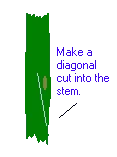Air Layering
This method of propagation is suitable for large houseplants such as Rubber Plants (Ficus elastic) Dieffenbachia, Dracaena and Swiss Cheese Plants (Monstera deliciosa)
It is particularly useful if you wish to reduce the height of your plant when they have lost their bottom leaves and become leggy and you wish to increase your stock at the same time.
Method -
Trim the leaves from a straight length of stem where you want the roots to form.
 With a sharp knife, make an upward slanted cut into the stem about ¼ inch (5mm) deep and 1 inch long. Ensure that you do not cut too far through the stem (or worse still right through the stem) or the top will collapse over.
With a sharp knife, make an upward slanted cut into the stem about ¼ inch (5mm) deep and 1 inch long. Ensure that you do not cut too far through the stem (or worse still right through the stem) or the top will collapse over.
Dust hormone rooting powder into the cut, ensuring that it goes under the 'tongue' that you have made.
 Push a small piece of damp Sphagnum Moss into the tongue and then wrap more damp moss around the stem to make a ball that covers the wound completely.
Push a small piece of damp Sphagnum Moss into the tongue and then wrap more damp moss around the stem to make a ball that covers the wound completely.
 Wrap clear polythene (kitchen cling film is ideal for this) around the moss and slightly overlap onto the stem. Ensure that there are no gaps left for moisture to escape and secure both ends with tape (preferably waterproof). This will create a warm, damp atmosphere for the roots to form into.
Wrap clear polythene (kitchen cling film is ideal for this) around the moss and slightly overlap onto the stem. Ensure that there are no gaps left for moisture to escape and secure both ends with tape (preferably waterproof). This will create a warm, damp atmosphere for the roots to form into.
It will take 2 or 3 months for roots to form and these will be seen penetrating the moss ball. When the roots have formed, carefully remove the plastic and moss and cut the stem free just below the new root formation.
Cut the stem at an angle just above a leaf node and pot the whole plant into compost.
Water well and treat as a rooted cutting.
© copyright 1999, P. A. Owen

